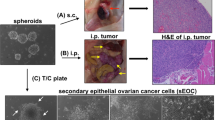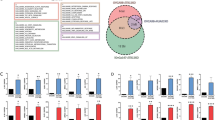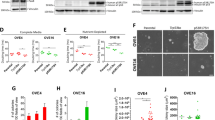Abstract
Cyclooxygenase 2 (COX-2) is often found overexpressed in cancer and is thought to have a role in carcinogenic promotion and thus is a target for therapeutic intervention. Here, we investigated the regulation of COX-2 expression in normal and cancer ovarian surface epithelial cells. Tumor necrosis factor alpha (TNF-α) is a potent inducer of COX-2 expression in the ovarian surface epithelium and this regulation is a critical step in ovulation. We observed that TNF-α stimulated COX-2 expression in human primary and immortalized epithelial (HIO) cell lines. The stimulation was suppressed by inhibitors of several signaling pathways, indicating the collaboration of TNF-α-activated signaling pathways mediates the regulation of COX-2 expression. In five ovarian cancer cell lines analysed, four did not express detectable COX-2 and TNF-α failed to elicit COX-2 expression. In NIH:OVCAR-5, the only ovarian cancer cell line expressing COX-2, signal pathway inhibitors no longer affected TNF-α-induced COX-2 expression. Thus, we conclude that TNF-α mediated signaling is uncoupled from the modulation of COX-2 expression in ovarian cancer. The loss of COX-2 expression was also observed to associate closely with epithelial neoplastic morphological transformation. The frequent loss of COX-2 expression suggests in ovarian cancer, unlike in other epithelial cancers, COX-2 expression does not contribute to ovarian cancer malignancy.
This is a preview of subscription content, access via your institution
Access options
Subscribe to this journal
Receive 50 print issues and online access
$259.00 per year
only $5.18 per issue
Buy this article
- Purchase on Springer Link
- Instant access to full article PDF
Prices may be subject to local taxes which are calculated during checkout







Similar content being viewed by others

Abbreviations
- COX:
-
cyclooxygenase
- FBS:
-
fetal bovine serum
- FSH:
-
follicle stimulating hormone
- HIO cells:
-
human ‘immortalized’ ovarian surface epithelial cells
- IL-1β:
-
interleukin 1-beta
- JNK:
-
Jun N-terminal kinase
- LH:
-
luteinizing hormone
- MAPK (ERK):
-
mitogen-activated protein kinase extracellular-signal regulated kinase
- OSE:
-
ovarian surface epithelial
- PGH2:
-
prostaglandin H2
- TNF-α:
-
tumor necrosis factor alpha
- TNFR:
-
TNF-α receptor
References
Akhmedkhanov AA, Toniolo P and Zeleninch-Jacquotte A . (2001). Soc. Gyn. Oncol., 80, 286.
Arnott CH, Scott KA, Moore RJ, Robinson SC, Thompson RG and Balkwill FR . (2004). Oncogene, 23, 1902–1910.
Baldwin AS . (1996). Annu. Rev. Immunol., 14, 649–683.
Barnes MN, Grizzle WE, Grubbs CJ and Partridge EE . (2002). CA Cancer J. Clin., 52, 216–225.
Barnes PJ and Karin M . (1997). N. Eng. J. Med., 336, 1066–1071.
Baud V and Karin M . (2001). Trends Cell Biol., 11, 372–377.
Boulton TG, Nye SH, Robbins DJ, IP NY, Radziejewska E, Morgenbesser SD, Depinho RA, Panayotatos N, Cobb MH and Yancopoulos GD . (1991). Cell, 65, 663–675.
Brannstrom M, Bonello N, Wang LJ and Norman RJ . (1995). Reprod. Fertil. Dev., 7, 67–73.
Chen G and Goeddel DV . (2002). Science, 296, 1634–1635.
Chun KS and Surh YJ . (2004). Biochem. Pharmacol., 68, 1089–1100.
Cramer D, Harlow B, Titus-Ernstaff L, Bohlke K, Welch WR and Greenberg ER . (1998). Lancet, 351, 104–107.
Davis BJ, Lennard DE, Lee CA, Tiano HF, Morham SG, Wetsel WC and Langenbach R . (1999). Endocrinology, 140, 2685–2695.
Denkert C, Kobel M, Pest S, Koch I, Berger S, Schwabe M, Siegert A, Reles A, Klosterhalfen B and Hauptmann S . (2002). Am. J. Path., 160, 893–903.
Dore M, Cote LC, Mitchell A and Sirois J . (1998). J. Histochem. Cytochem., 46, 77–84.
Downs SM and Longo FJ . (1982). Am. J. Anat., 164, 265–274.
Duffy DM and Stouffer RL . (2001). Mol. Hum. Reprod., 7, 731–739.
Espey LL . (1994). Biol. Reprod., 50, 233–238.
Ferrandina G, Ranelletti FO, Lauriola L, Fanfani F, Legge F, Mottolese M, Nicotra MR, Natali PG, Zakut VH and Scambia G . (2002). Gynecol. Oncol., 85, 305–310.
Fong CY, Pang L, Holland E and Knox AJ . (2000). Am. J. Physiol. Lung Cell Mol. Physiol., 279, L201–L207.
Ghosh S and Baltimore D . (1990). Nature, 344, 678–682.
Gupta RA, Tejada LV, Tong BJ, Das SK, Morrow JD, Dey SK and DuBois RN . (2003). Cancer Res., 63, 906–911.
Hamilton TC, Young RC, Louie KG, Behrens BC, McKoy WM, Grotzinger KR and Ozols RF . (1984). Cancer Res., 44, 5286–5290.
Howe LR and Dannenberg AJ . (2002). Semin. Oncol., 29, 111–119.
Hsu H, Xiong J and Goeddel DV . (1995). Cell, 81, 495–504.
Klimp AH, Hollema H, Kempinga C, van der Zee AG, de Vries EG and Daemen T . (2001). Cancer Res., 61, 7305–7309.
Komori A, Yatsunami J, Suganuma M, Okabe S, Abe S, Sakai A, Sasaki K and Fujiki H . (1993). Cancer Res., 53, 1982–1985.
Lal G, Ash C, Hay K, Redston M, Kwong E, Hancock B, Mak T, Kargman S, Evans JF and Gallinger S . (2001). Cancer Res., 61, 6131–6136.
Leahy KM, Ornberg RL, Wang Y, Zweifel BS, Koki AT and Masferrer JL . (2002). Cancer Res., 62, 625–631.
Lim H, Paria BC, Das SK, Dinchuk JE, Langenbach R, Trzaskos JM and Dey SK . (1997). Cell, 91, 197–208.
Liu CH, Chang SH, Narko K, Trifan OC, Wu MT, Smith E, Haudenschild C, Lane TF and Hla T . (2001). J. Biol. Chem., 276, 18563–18569.
Malik STA, Griffin DB, Fiers W and Balkwill FR . (1989). Int. J. Cancer, 44, 918–925.
Malik STA, Naylor MS, East N, Oliff A and Balkwill FR . (1990). Eur. J. Cancer, 26, 1031–1034.
Masferrer J . (2001). Cancer J. Suppl., 3, S144–S150.
Masferrer JL, Leahy KM, Koki AT, Zweifel BS, Settle SL, Woerner BM, Edwards DA, Flickinger AG, Moore RJ and Seibert K . (2000). Cancer Res., 60, 1306–1311.
Matsumoto Y, Ishiko O, Deguchi M, Nakagawa E and Ogita S . (2001). Int. J. Mol. Med., 8, 31–36.
Moore BC and Simmons DL . (2000). Curr. Med. Chem., 7, 1131–1144.
Moore RJ, Owens DM, Stamp G, Arnott C, Burke F, East N, Holdsworth H, Turner L, Rollins B, Pasparakis M, Kollias G and Balkwill F . (1999). Nat. Med., 5, 828–831.
Munkarah AR, Morris R, Baumann P, Deppe G, Malone J, Diamond MP and Saed GM . (2002). J. Soc. Gyn. Invest., 9, 168–173.
Murdoch WJ, Colgin DC and Ellis JA . (1997). J. Anim. Sci., 75, 1601–1605.
Nabors LB, Suswam E, Huang Y, Yang X, Johnson MJ and King PH . (2003). Cancer Res., 63, 4181–4187.
Nasi ML and Castiglione M . (2002). Ann. Oncol., 13, 1169–1171.
Ness RB and Cottreau C . (2000). J. Natl. Cancer Inst., 91, 1459–1467 Response: J. Natl. Cancer Inst., 92, 163, 2000.
Norman RJ . (2001). Lancet, 358, 1287–1288.
Okamura H, Fukumoto M and Mori T . (1985). Adv. Prostagl. Throm. Leuk. Res., 15, 597–599.
Old LJ . (1985). Science, 230, 630–632.
Oshima M, Dinchuk JE, Kargman SL, Oshima H, Hancock B, Kwong E, Trzaskos JM, Evans JF and Taketo MM . (1996). Cell, 87, 803–809.
Pall M, Friden BE and Brannstrom M . (2001). Hum. Reprod., 16, 1323–1328.
Prescott SM and Fitzpatrick FA . (2000). Biochim. Biophys. Acta, 1470, M69–M78.
Richards JS, Russell DL, Ochsner S and Espey LL . (2002). Annu. Rev. Physiol., 64, 69–92.
Rodriguez-Burford C, Barnes MN, Oelschlager DK, Myers RB, Talley LI, Partridge EE and Grizzle WE . (2002). Clin. Cancer Res., 8, 202–209.
Roland IH, Yang WL, Yang DH, Daly MB, Ozols RF, Hamilton TC, Lynch HT, Godwin AK and Xu XX . (2003). Cancer, 98, 2607–2623.
Schilder RJ, Hall L, Monks A, Handel LM, Fornace Jr AJ, Ozols RF, Fojo AT and Hamilton TC . (1990). Int. J. Cancer, 45, 416–422.
Shigemasa K, Tian X, Gu L, Shiroyama Y, Nagai N and Ohama K . (2003). Int. J. Oncol., 22, 99–105.
Siemens CH and Auersperg N . (1988). J. Cell. Physiol., 134, 347–356.
Singer CA, Baker KJ, McCaffrey A, AuCoin DP, Dechert MA and Gerthoffer WT . (2003). Am. J. Physiol. Lung Cell Mol. Physiol., 285, L1087–L1098.
Smith ER, Daly MB and Xu XX . (2004). CEBP, 13, 144–145.
Sorensen HT, Friis S, Norgard B, Mellemkjaer L, Blot WJ, McLaughlin JK, Ekbom A and Baron JA . (2003). Br. J. Cancer, 88, 1687–1692.
Steinbach G, Lynch PM, Phillips RK, Wallace MH, Hawk E, Gordon GB, Wakabayashi N, Saunders B, Shen Y, Fujimura T, Su LK and Levin B . (2000). N. Engl. J. Med., 342, 1946–1952.
Subbaramaiah K and Dannenberg AJ . (2002). Trends Pharm. Sci., 24, 96–102.
Suganuma M, Okabe S, Marino NW, Sakai A, Sueoka E and Fujiki H . (1999). Cancer Res., 59, 4516–4518.
Terranova PF and Rice VM . (1997). Am. J. Reprod. Immun., 37, 50–63.
Tiano HF, Loftin CD, Akunda J, Lee CA, Spalding J, Sessoms A, Dunson DB, Rogan EG, Morham SG, Smart RC and Langenbach R . (2002). Cancer Res., 62, 3395–3401.
Tokuyama O, Nakamura Y, Muso A, Honda K, Ishiko O and Ogita S . (2001). Int. J. Mol. Med., 8, 603–606.
Trifan OC and Hla T . (2003). J. Cell. Mol. Med., 7, 207–222.
Tsafriri A and Reich R . (1999). Exp. Clin. Endoc. Diabetes, 107, 1–11.
Wang H, Ma WG, Tejada L, Zhang H, Morrow JD, Das SK and Dey SK . (2004). J. Biol. Chem., 279, 10649–10658.
Wang S and El-Deiry WS . (2003). Oncogene, 22, 8628–8633.
Williams CS, Mann M and DuBois RN . (1999). Oncogene, 18, 7908–7916.
Williams CS, Watson AJ, Sheng H, Helou R, Shao J and DuBois RN . (2000). Cancer Res., 60, 6045–6051.
Yang DH, Smith ER, Cohen C, Wu H, Patriotis C, Godwin AK, Hamilton TC and Xu XX . (2002). Cancer, 94, 2380–2392.
Yang WL, Godwin AK and Xu XX . (2004). Cancer Res., 64, 1534–1540.
Acknowledgements
We appreciate Dr Elizabeth Smith for reading, proofing and commenting during the process of preparing the manuscript. We have been greatly assisted by the Histopathology Core (Core B of FCCC Ovarian SPORE) in tissue analysis. We thank Malgorzata Rula, Jennifer Smedberg and Cory Staub for their technical assistance and Ms Patricia Bateman for her excellent secretarial support. This work was supported by Grants R01 CA79716 and R01 CA75389 to XX Xu from NCI, NIH and funds from Ovarian Cancer SPORE P50 CA83638 (RF Ozols, PI). The work was also supported by an appropriation from the Commonwealth of Pennsylvania.
Author information
Authors and Affiliations
Additional information
Note added in proof
During the review of the manuscript, a recent paper by Gubbay et al (Inflammation-associated gene expression is altered between normal human ovarian surface epithelial cells and cell lines derived from ovarian adenocarcinomas. Br. J. Cancer, 2005 May 23; 92: 1927–1933.) was published. They conclude that ovarian cancer cells fail to responsd to IL-1α stimulation for COX-2 induction. The finding is complementary to the conclusion of the current study, suggesting the association of loss of cytokine responsive activity with neoplastic transformation in ovarian epithelial cells.
Rights and permissions
About this article
Cite this article
Yang, WL., Roland, I., Godwin, A. et al. Loss of TNF-α-regulated COX-2 expression in ovarian cancer cells. Oncogene 24, 7991–8002 (2005). https://doi.org/10.1038/sj.onc.1208943
Received:
Revised:
Accepted:
Published:
Issue Date:
DOI: https://doi.org/10.1038/sj.onc.1208943


